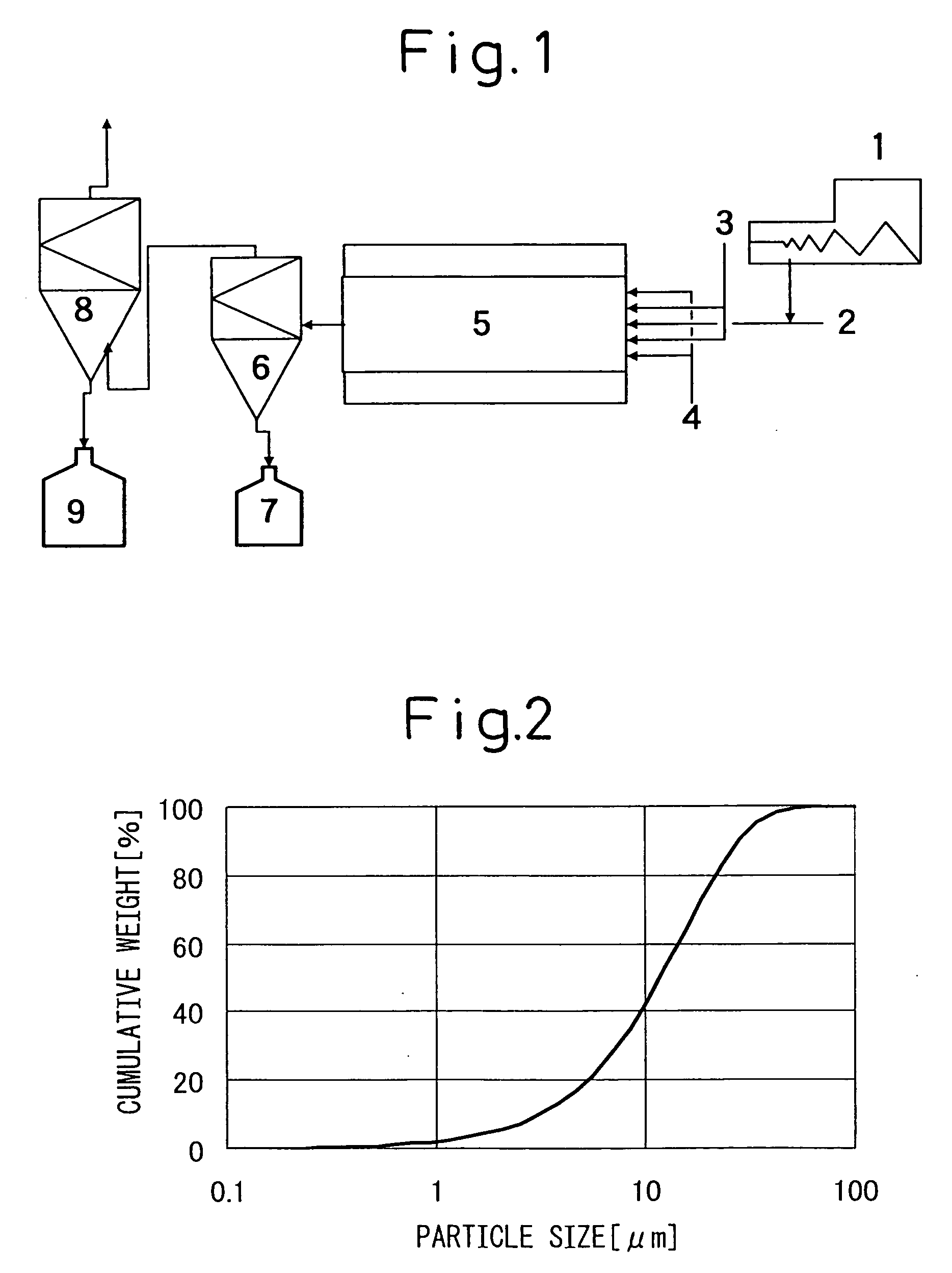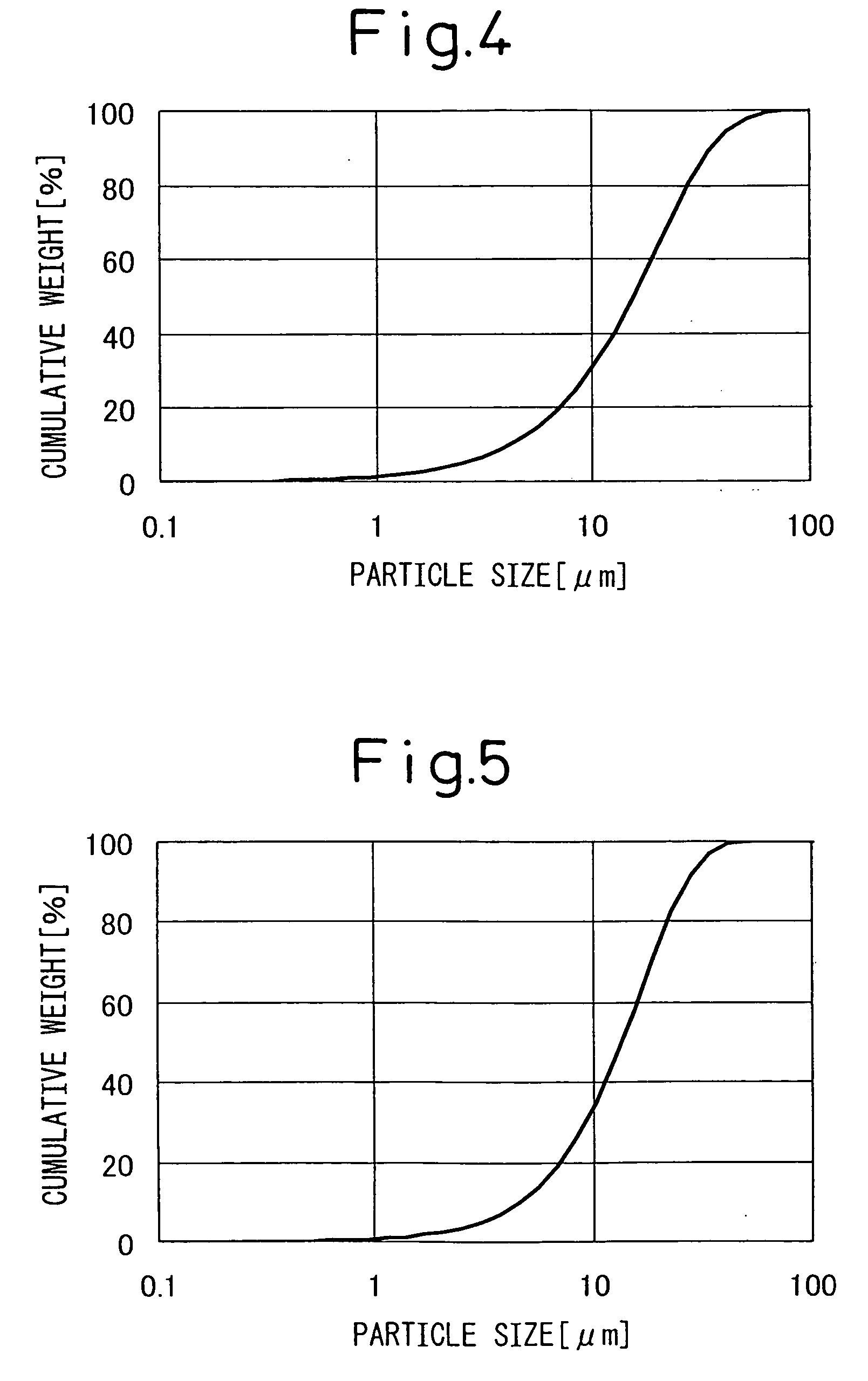Surface modification method for inorganic oxide powder, powder produced by the method and use of the powder
- Summary
- Abstract
- Description
- Claims
- Application Information
AI Technical Summary
Benefits of technology
Problems solved by technology
Method used
Image
Examples
example 1
[0084] Gaseous titanium tetrachloride (concentration: 100%) was preliminarily heated to 1,000° C. Separately, a gas mixture of oxygen (96 vol. %) and steam (4 vol. %) was preliminarily heated to 1,000° C. The titanium tetrachloride gas and the gas mixture were brought into a reaction tube through a coaxial parallel-flow nozzle at flow rates of 45 m / second and 50 m / second, respectively. The titanium tetrachloride gas was fed through the inner tube. The flow rates of the titanium tetrachloride gas and the gas mixture in the reaction tube were found to be 8 m / second (calculated value) at a reaction temperature of 1,630° C. Cooling air was brought into the reaction tube such that the high-temperature residence time of the resultant reaction mixture was 0.1 seconds or less in the reaction tube. Thereafter, the thus-produced titanium dioxide powder was collected by use of a polytetrafluoroethylene-made bag filter.
[0085] The thus-produced titanium dioxide powder was found to have a BET-ba...
example 2
[0091] Gaseous aluminum chloride which had been diluted with nitrogen (concentration of aluminum chloride: 60%) was heated to 1,000° C. Separately, a gas mixture of oxygen (40 vol. %) and steam (60 vol. %) was heated to 1,000° C. The aluminum chloride gas and the gas mixture were brought into a reaction tube through a coaxial parallel-flow nozzle at flow rates of 40 m / second and 30 m / second, respectively. The aluminum chloride gas was fed through the inner tube. After completion of reaction, cooling air was brought into the reaction tube such that the high-temperature residence time of the resultant reaction mixture was 0.1 seconds or less in the reaction tube. Thereafter, the thus-produced alumina powder was collected by use of a polytetrafluoroethylene-made bag filter.
[0092] The thus-produced aluminum oxide powder was found to have a BET-based particle size of 37 nm and to predominantly contain a δ-alumina crystal phase. The aluminum oxide powder was employed as powder B (raw mat...
example 3
[0097] Gaseous aluminum chloride which had been diluted with nitrogen (concentration of aluminum chloride: 26%) was preliminarily heated to 1,000° C. Separately, a gas mixture of oxygen (35 vol. %) and steam (65 vol. %) was preliminarily heated to 1,000° C. The aluminum chloride gas and the gas mixture were brought into a reaction tube through a coaxial parallel-flow nozzle at flow rates of 61 m / second and 55 m / second, respectively. The aluminum chloride gas was fed through the inner tube. After completion of reaction, cooling air was brought into the reaction tube such that the high-temperature residence time of the resultant reaction mixture was 0.1 seconds or less in the reaction tube. Thereafter, the thus-produced alumina powder was collected by use of a polytetrafluoroethylene-made bag filter.
[0098] The thus-produced aluminum oxide powder was found to have a BET-based particle size of 15 nm and to predominantly contain a γ-alumina crystal phase. The aluminum oxide powder was e...
PUM
| Property | Measurement | Unit |
|---|---|---|
| Length | aaaaa | aaaaa |
| Percent by mass | aaaaa | aaaaa |
| Percent by mass | aaaaa | aaaaa |
Abstract
Description
Claims
Application Information
 Login to View More
Login to View More - R&D
- Intellectual Property
- Life Sciences
- Materials
- Tech Scout
- Unparalleled Data Quality
- Higher Quality Content
- 60% Fewer Hallucinations
Browse by: Latest US Patents, China's latest patents, Technical Efficacy Thesaurus, Application Domain, Technology Topic, Popular Technical Reports.
© 2025 PatSnap. All rights reserved.Legal|Privacy policy|Modern Slavery Act Transparency Statement|Sitemap|About US| Contact US: help@patsnap.com



